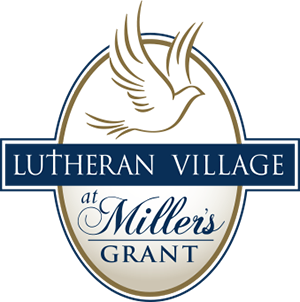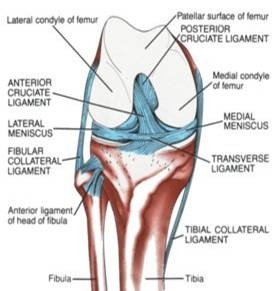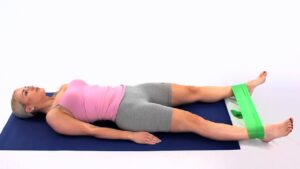Health Talk: Your Knee
Our Director of Rehabilitation, Sheetal Patel, covers “The What & The Why, The Pain & The Strength” of one of our most complex joints. She reviews the anatomy, function, conditions, risks and therapeutic exercises. Watch her health talk or read the transcript below.
Subscribe to our YouTube channel.
Good afternoon everybody. My name is Sheetal. I’m the director of rehab here. Today I am going to just give you a little bit of information on the knee: The What & The Why, The Pain & The Strength.
Before we do that, I wanted to say, it has been great seeing everyone in the last week. I know things are changing very quickly. We are all worried, and I completely understand that, so please be safe. Please be diligent.
The therapy department is open, of course. We are essential; we’re there for you. We’re following all precautions with PPE (personal protective equipment), so those of you who are already coming down, please feel safe. If you have any concerns, let me know. Those of you that are hesitating or have questions, please give me a call, and we can definitely talk.
Alright, let’s get on with today’s presentation.
Anatomy
Let’s go over the anatomy of the knee. It is the largest and most complex join in the body, and when I show you some of the pictures you will see why.
You know that song it “connects the thigh bone to the leg bone” and so on and so on? It really does, because it’s between two larger bones, one of them being the femur (i.e. the thigh bone), which is the longest bone in the body. It really does affect us in many different ways. The other parts are the fibula, which is the side bone within our leg, tibia and kneecap. Plus, you have cartilage and ligaments that also make up the knee joint.
In looking at the anatomy of the knee, there’s the patella. Farther down there’s a larger bone, the tibia; the side bone, which helps to make the end part of it the ankle, and there’s the fibula. Behind your quadriceps muscle is the femur, the longest bone in the body. When I say it’s complex, you can see it really is. There are so many different components.
Looking at more of the outside of that bony component, there are all kinds of tendons. With the quadriceps muscle, tendon attaches above the knee, and the retinaculum comes over the kneecap, which attaches to the patellar tendon.
It really is as we say, attached. Those two bones are attached by many components.
Then there’s the hamstrings that come around and attach into your bone below the tibia. Essentially, there are two large bulk muscles coming into play: the quadriceps and hamstrings, which is behind the thigh.
Within that joint space is cartilage, which cushions. There’s meniscus, menisci and lateral medial meniscus. You may be familiar with meniscal surgeries, which occurs when you have a slight tear. Surgeons remove those sections arthroscopically, if the tear is small enough.
There are other ligaments that come into play like the anterior cruciate ligament (ACL), our posterior cruciate. Some football players who recently had ACL surgeries, are now in rehab.
There are also two ligaments on the side – the medial collateral and lateral collateral. Sometimes when you twist your knee you’ll feel pain on the inside of your knee or the outside of your knee. That’s what you feel when you strain that ligament. You can also tear it when you get an ACL tear, your anterior cruciate. That’s a more hefty a surgery.
That basically explains why the knee joint is one of the most complex in the body.
Functions
The knee provides us with mobility. It supports the body during dynamic (e.g. walking, squatting and sitting) and stable (e.g. hip and knee or ankle and knee movement) activities.
Conditions
We can definitely have specific injuries including:
- ACL/Ligament
I touched base on the ACL or ligament injuries, of any kind, when I mentioned football. When you twist and fall, you can definitely pull the ACL ligament out, tear it or strain it. You will feel a little bit of wobble in your knee. - Fractures
It could be a patellar, tibia ore fibula fracture. With the leg bones, that can definitely happen. - Torn meniscus
I talked about a torn meniscus earlier. - Bursitis
We do have a bursa right there. - Tendinitis
It’s the inflammation of the tendons. There are the hamstring, quadriceps and patellar tendons, so there are definitely a few opportunities for injuring or inflaming the tendons.
Other joint conditions can be actual medical issues.
- Loose body – where you have a loose body within the knee joint
- Iliotibal band syndrome (ITB)
- Patella dislocation
- Hip or foot pain
This is a really important one because the knee joint connects to joints that are higher up (i.e. hip joint) and lower down (i.e. ankle joint). Issues with your knee can affect the chain up or below.
Arthritis is another condition. I won’t go into a lot of detail; I did an arthritis presentation earlier. There are different types of arthritis including:
- Osteoarthritis
- Rheumatoid arthritis, which can affect any joint but is more common in the hands, wrists and fingers.
- Gout or pseudo gout, which affects the knee joint. If you have had gout you know that’s one of the first joints, whether it’s the ankle or knee, that really inflames. It’s that shinny kind of red coloring and swelling that you’re seeing.
- Septic arthritis
All of these cause pain and hence we will see a lot of the issues that you may have with walking or any weight-bearing activities.
I just added in patellofemoral pain (PFP), but really any kind of pain. It does not have to be pain under the kneecap and above the femur. It could truly be any kind of pain that you’re having in your muscle, joint or tendon.
Risks
I’m going to cover some that may and may not seem obvious.
- Excess weight
What I mean, and many females who have been pregnant may be able to relate to this, is that it’s not just the stomach that’s causing us to trip and fall and have difficulty getting up. It’s that extra added weight. We have not suddenly gotten taller; we are still the same height, but that extra weight is causing pain in our hips and knees.
Let’s say for every four pounds you gain, your joint actually feels like it’s 10 pounds of weight with each step, so if I gain four pounds, I feel like it’s 40 pounds. Our joints really feel the effects of any amount of weight gained. - Lack of muscle flexibility or strength
Strength is pretty obvious. If we’re weak, we have trouble with endurance or stepping up or climbing things, whether it be the curb, getting in and out of a car, and going from a sitting to a standing position. Those are going to cause issues.
If we are not as flexible as we should be and are trying to move around or bend down and one muscle is tighter than the other, the muscle will pull back on the knee joint where it should not be pulled that much. For instance, if our hamstrings are tight and are quads are fine, loose – whichever way – or slightly tight, the lever arm changes on our joint so that hamstring muscle, because it’s tight, pulls back on our knee joint where it shouldn’t be pulled that much.
Flexibility really matters. I know the fitness classes are virtual now, but they focus on stretching. Don’t forget the stretching portion of your exercises. - Certain sports or occupations
We mentioned football, but any kind of contact sport, is a risk factor.
With occupations, we can consider anything that is causing repetitive movements, such as factory jobs where you are standing for a long time and constantly repeating the same motion through the day. - Prior injury
If you have injured yourself when you were 16, you are more likely to feel that a little bit more at 60. A way to combat that is to consider your strength, flexibility and the amount of weight you have on your body. - Hip and ankle issues
These are really key because it’s not just about your knee joint rather it’s the whole leg – that lower limb and the hip, ankle and knee joints. They all need to work together.
Therapeutic Exercises
This is the most exciting part. There are so many options for treatment we get, whether it’s pain medication, something over the counter or an injection. However, therapeutic exercises are the easiest because not only do you have therapy here, but you can do it on your own.
There are so many things you can do. We’ll start with the basics, and we’ll kind of formulate a plan.
We have what we call closed chain versus open chain. Closed chain, is when your foot is planted and you are not free form. You’re feet are planted and all the exercises are coming above your foot. Open chain is when your foot is not on the floor.
We’ll go over some specific exercises.
View Patel demonstrate the following closed and open chain exercises.
Closed Chain
- Squats
- Lunges
- Step Ups
- Leg press
It’s a machine you see in the gym, and that’s a closed chain because your feet are planted against the plate, and then you’re just pushing it forwards and backwards. - Terminal knee extension with Theraband
Open chain
- Quadricep machine
- Hamstring machine
- Straight leg raise
- Quad sets
You’re laying down and squeezing the knee into the bed or mat table that you’re on.
Ankle
I have been constantly talking about your ankle and hip. So why is that? If my ankle is not strong or it’s unstable, and I am not walking heel to toe but am walking sort of on the outside of my foot or I am completely pronated like I am walking on the inside, it really affects the inside of your knee.
If we think about the anatomy on the inside of that knee, we have the MCL, the medial collateral ligament. If I am constantly putting pressure on that MCL all the time with every step I take, I’m always going to be sore on the inside, right? So, we need to definitely work on our ankle strength.
View Patel demonstrate the following ankle and hip exercises.
Hip
- Hip machine
- Hip machine with Theraband
- TheraBand Exercises in supine or standing
You’ll notice the picture I have up here, she’s laying on a mat, and kicking her hip out. There are so many different exercises that can you can really do for any of these joints. - Prone
The reason we went through all these exercises – the hip exercises that are all in standing and sitting – it’s not meant to be not a program for you. I’m not creating this individually for you so some of these may be appropriate for your level but some may not. It really it depends on the type of pain you are having.
Sometimes we just get some joint stiffness or soreness, and we really do need to keep up with some strengthening exercises or some stretching exercises and programs. If your pain is severe and you’re just not able to get it under control, I definitely recommend you seeing your primary care physician or an orthopedist or to speak with Jenna Britton or myself.
Learn about our Rehabilitation services including outpatient services for Howard County residents who have Medicare as their primary insurance.


